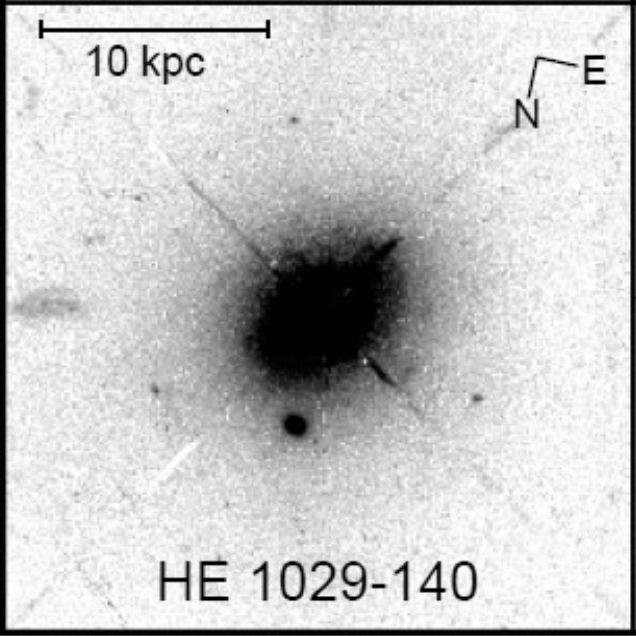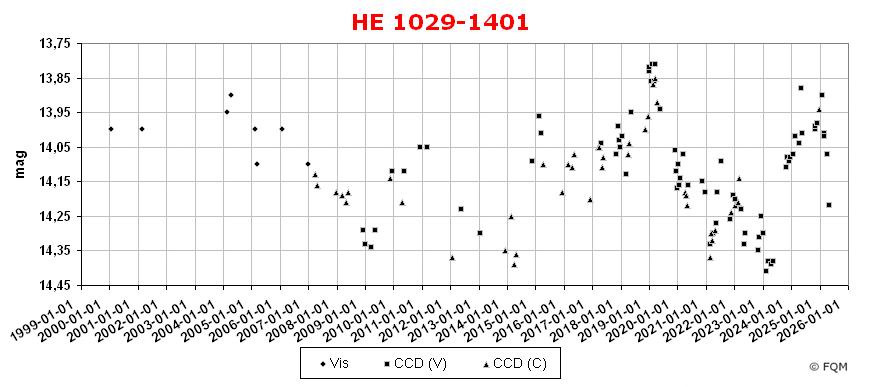
| Frankfurt Quasar Monitoring |
| HE 1029-1401 |
| Cross-Identifications | EC 10294-1401, H 1029-140, 1RXS J103155.8-141659 2MASS J10315431-1416514, QSO B1029-140, 1029-140 1AXG J103154-1416, 1XMM J103154.4-141652, RBS 880 GALEXASC J103154.34-141651.1, SWIFT J1031.9-1417 WISEA J103154.31-141651.3, LQAC 157-014 001 |
| Equat. coordinates | RA 10 31 54.4 DE -14 16 52 (J2000) |
| Constellation | Hydra |
| Type | QSO |
| Redshift (1) |
z=0.086 |
| Distance (2) (3) | 351 Mpc |
| Total mag range (mv) (4) (5) | 13.6 - 14.4 |
| Catalog Magnitude (1) | 13.86 |
| Absolute Magnitude (1) | -24.5 MB |
| Light Travel-Time (2) | 1.098 × 109 yrs |

Comparison stars
| star | B | V |
| 1 | 13.949 (0.068) | 13.242 (0.028) |
| 2 | 14.127 (0.056) |
13.406 (0.043) |
| 3 | 14.780 (0.051) |
13.772 (0.028) |
| 4 | 15.363 (0.043) | 14.567 (0.045) |
| 5 | 15.574 (0.072) | 14.792 (0.047) |
| 6 |
15.904 (0.066) | 15.058 (0.065) |


| HE
1029-1401 is a bright quasar in Hydra, close to the constellation
Crater. At the time of the discovery, HE 1029-1401
was one of the 3 optically brightest quasars in the heavens, and the
brightest quasar ever discovered in the optical! No question: HE
1029-1401 is the brightest radio-quiet QSO in the southern sky. HE 1029-1401 was discovered in the 1980s by the Edinburgh-Cape Blue Object Survey (EC) with the UK-Schmidt Telescope at the Anglo Australian Observatory (AAO). The designation HE 1029-1401 refers to the Hamburg/ESO Survey of Bright Quasars (HE), where this object was finally confirmed as a quasar in 1990. This quasar resides in a very luminous type E1 elliptical host, which shows signs of an advanced stage of merger with a highly disturbed companion galaxy. HE 1029-1401 is a small amplitude variable quasar with a total variability of about 1 magnitude, ranging between 13.6 mv and 14.4 mv. No data on significant optical variability have been published to date. Observations by the Frankfurt Quasar Monitoring programme have confirmed an optical variability ranging between 13.8-14.4 mv, very close to the data from the literature. HE 1029-1401 appears stellar for both CCD cameras and visual observers with telescopes of 8- to 10-inch of aperture and larger. CCD observers, as well as visual observers, shall use the comparison stars given above. ____________
When observing quasar HE 1029-1401, do not forget to visit bright planetary nebula NGC 3242, about 4.6° to the south. NGC 3242 is dubbed the "Ghost of Jupiter", due to its remarkable greenish-blue colour. Variable star observers may like to take a look at bright variable U Hya (4m.7-6m.2), only 1.6° NE of the quasar. U:Hya is a carbon star with particularly reddish color during minimum brightness - a nice catch for small telescopes. |
| Bahcall, J.N., Kirhakos, S., et al. 1997, ApJ, 479, 642; Hubble Space Telescope images of a sample of 20 nearby luminous quasars. Bowen, D.V., Osmer, S.J., Blades, J.C., et al. 1994, AJ, 107, 461; Hubble Space Telescope faint object spectrograph QSO absorption snapshot survey (ABSNA). Husemann, B., Sanchez, S.F., et al. 2010, A&A, 519, 115; Mapping the ionised gas around the luminous QSO HE 1029-1401: Evidence for minor merger events? Jahnke, K., Kuhlbrodt, B., Wisotzki, L. 2004, MNRAS, 352, 399; Quasar host galaxy star formation activity from multicolour data. Karge, S.; Helle Quasare für 8- bis 10-Zoll Teleskope. Ein Beobachtungsführer zur visuellen Beobachtung von Quasaren und BL Lacertae Objekten; Frankfurt 2005. Kilkenny, D., O'Donoghue, D., et al. 1997, MNRAS, 287, 867; The Edinburgh-Cape Blue Object Survey - II. Zone 1 - the North Galactic Cap. Reimers, D., Kohler, T., Wisotzki, L. 1996, A&AS, 115, 235; The Hamburg/ESO survey for bright QSOs. II. Follow-up spectroscopy of 160 quasars and Seyferts. Steinicke, W.; Beobachtungsliste für helle Quasare; Umkirch 1999. Stobie, R.S., Kilkenny, D. 1997, MNRAS, 287, 848; The Edinburgh-Cape Blue Object Survey - I. Description of the survey. Véron-Cetty, M.-P., Véron, P. 2001, A&A 374, 92; A Catalogue of Quasars and Active Nuclei: 10th edition. Véron-Cetty, M.-P., Véron, P. 2003, A&A 412, 399; A Catalogue of Quasars and Active Nuclei: 11th edition. Véron-Cetty, M.-P., Véron, P. 2006, A&A 455, 776; A Catalogue of Quasars and Active Nuclei: 12th edition. Véron-Cetty, M.-P., Véron, P. 2010, A&A 518, 10; A Catalogue of Quasars and Active Nuclei: 13th edition. Wisotzki, L., Wamsteker, W., Reimers, D. 1991, A&A, 247, 17L; Discovery of a new bright southern QSO. |
Links: HQM APASS |
| home |